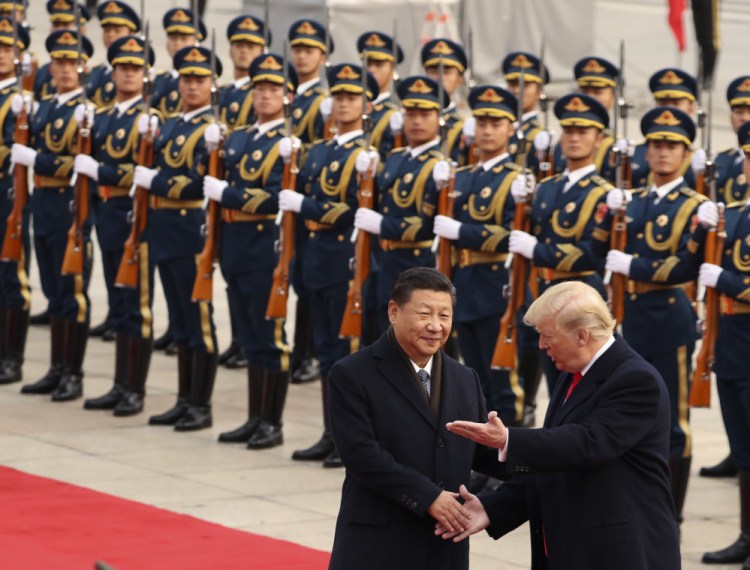WASHINGTON — President Trump couldn’t stop talking about the red carpets, military parades and fancy dinners that were lavished upon him during state visits on his recent tour of Asia. “Magnificent,” he declared at one point on the trip.
But Trump has yet to reciprocate, making him the first president in almost a century to close his first year in office without welcoming a visiting counterpart to the U.S. with similar trappings.
Trump spoke dismissively of state dinners as a candidate, when he panned President Barack Obama’s decision to welcome Chinese President Xi Jinping with a 2015 state visit. Such visits are an important diplomatic tool that includes a showy arrival ceremony and an elaborate dinner at the White House.
“I would not be throwing (Xi) a dinner,” Trump said at the time. “I would get him a McDonald’s hamburger and say we’ve got to get down to work.”
Last month it was Xi’s turn to literally roll out the red carpet. The Chinese leader poured on the pageantry as he welcomed Trump to Beijing on what was billed as a “state visit, plus.” Trump also made state visits to South Korea and Vietnam.
White House press secretary Sarah Huckabee Sanders said there is no “singular reason” why Trump hasn’t extended a state visit invitation yet, but added that the administration hopes to schedule a visit early in 2018. Sanders gave no hints about which of Trump’s foreign counterparts are being considered for the diplomatic honor.
A state visit typically is offered as a sign of friendship and to showcase strategic ties between countries that are important to each other, said Anita McBride, a veteran of three Republican administrations who last served as chief of staff to first lady Laura Bush.
“The White House is the world stage to elevate that,” she said. “These occasions really go a long way to solidify and strengthen relationships.”
Trump speaks often about his relationships with many of his foreign counterparts, including Xi. Trump and the Chinese leader met at Trump’s Florida estate in April, and Trump treated Xi to a full dinner.
Trump has also met at the White House, sometimes over lunch as well as abroad, with many of his foreign counterparts. He recently put the figure at more than 100.
But nothing compares to a state visit.
The White House portion of the visit begins with an elaborate arrival ceremony on the South Lawn, including the pomp of a military honor guard, a troop review and leader statements. The leaders meet privately in the Oval Office before they hold a joint news conference in the East Room or the Rose Garden. The evening ends with the foreign leader as the guest of honor at a lavish state dinner attended by hundreds, including members of Congress, business leaders, celebrities, political donors and others.
The visiting leader also has lunch at the State Department, and sometimes will address a joint meeting of Congress.
Such visits are reserved for when the U.S. wants to put on its “best face” for a particular leader and ally, said Peter Selfridge, who served as a liaison between the White House and visiting foreign dignitaries as U.S. chief of protocol from 2014 to January 2017.
“It’s a really important arrow in a president’s quiver when it comes to the diplomatic nicety side of his work,” Selfridge said.
McBride said Trump’s decision to not extend a state visit invitation could be partly because his first year was a chaotic one, dominated by staff upheaval and lengthy negotiations with Congress over health care and tax legislation. Separately, the first lady, who is responsible for planning a state dinner down to the smallest detail, didn’t officially relocate to the White House until June. A state visit is also a massive undertaking and Trump has been running the government with a bare-bones staff.
But Trump’s first state visitor will matter. “The other world leaders will pay attention to that,” McBride said.
Not since Calvin Coolidge in the 1920s has a president ended his first year in office without hosting a foreign leader for a state visit, according to the White House Historical Association.
Coolidge assumed office in 1923 after the sudden death of President Warren G. Harding, and was elected to a full term in 1924. Coolidge didn’t hold a state dinner until October 1926 for Queen Marie of Romania, according to the White House association.
Every president since Coolidge has hosted at least one state visit their first year.
Lyndon Johnson held 12 in 1964, his first full year in office after President John F. Kennedy’s assassination in 1963. Barack Obama, Trump’s immediate predecessor, held just one in 2009 – and it was famously crashed by a celebrity-seeking couple.
Earlier this year, Trump was the special guest of President Emmanuel Macron at France’s Bastille Day parade. Trump has also accepted an invitation from Queen Elizabeth II for a state visit. Sanders said she expects those details will be announced soon.
Copy the Story LinkSend questions/comments to the editors.



Success. Please wait for the page to reload. If the page does not reload within 5 seconds, please refresh the page.
Enter your email and password to access comments.
Hi, to comment on stories you must . This profile is in addition to your subscription and website login.
Already have a commenting profile? .
Invalid username/password.
Please check your email to confirm and complete your registration.
Only subscribers are eligible to post comments. Please subscribe or login first for digital access. Here’s why.
Use the form below to reset your password. When you've submitted your account email, we will send an email with a reset code.